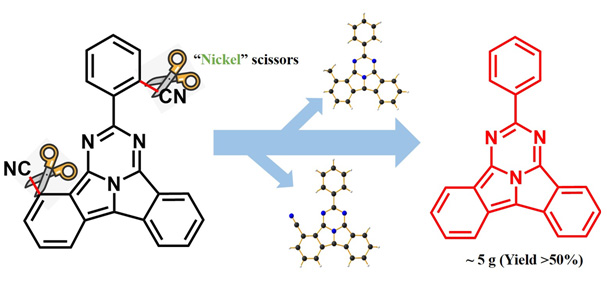| [1] |
Zheng, W.; Zhao,Y.; Zhuang, W.-H.; Wu, J.-J.; Wang, F.-Z.; Li, C.-H.; Zuo, J.-L. Angew. Chem., Int. Ed . 2018, 57,15384.
|
| [2] |
Wang, K.; Wang, H.-L.; John, M; L, W.-J.; Kobayashi N; Jiang, J.-Z. Acta Chim. Sinica 2012, 70, 1791 . (in Chinese)
|
|
王康, 王海龙, 约翰·马克, 李文军, 小林长夫, 姜建壮, 化学学报, 2012, 70, 1791.
|
| [3] |
Zhang, M.-J.; Pan, Q.-J.; Guo, Y.-R.; Zhang, H.-X. Acta Chim. Sinica 2014, 72, 697 . (in Chinese)
|
|
张明晶, 潘清江, 郭元茹, 张红星, 化学学报, 2014, 72, 697.
|
| [4] |
Roy, S.; Reisner, E. Angew. Chem., Int. Ed . 2019, 58, 12180.
|
| [5] |
Zhang, X.-X.; Chen, C.-Y. Acta Chim. Sinica 2012, 70, 2475 . (in Chinese)
|
|
张现侠, 陈灿玉, 化学学报, 2012, 70, 2475.
|
| [6] |
Zeng, K.-W.; Chen, Y.-Y.; Zhu, W.-H.; He, T.; Xie, Y.-S. J. Am. Chem. Soc. 2020, 142, 5154.
|
| [7] |
Zeng, K.-W.; Tong, Z.-F.; Ma, L.; Zhu, W.-H.; Wu, W.-J.; Xie, Y.-S. Energy Environ. Sci. 2020, 13, 1617.
|
| [8] |
Kurumisawa, Y.; Higashino, T.; Nimura, S.; Tsuji, Y.; Iiyama, H.; Imahori, H. J. Am. Chem. Soc. 2019, 141, 9910.
|
| [9] |
Ding, Y.-B.; Zhu, W.-H.; Xie, Y.-S. Chem. Rev. 2017, 117, 2203.
|
| [10] |
Zheng, W.; Wang, B.-B.; Li, C.-H.; Zhang, J.-X.; Wan, C.-Z.; Huang, J.-H.; Liu, J.; Shen, Z.; You, X.-Z. Angew. Chem., Int. Ed . 2015, 54, 9070.
|
| [11] |
Zheng, W.; Li, C.-H. Synlett 2020, 31, 1231.
|
| [12] |
Patra, T.; Agasti, S.; Akanksha; Maiti, D. Chem. Commun. 2013, 49, 69.
|
| [13] |
Tobisu, M.; Nakamura, R.; Kita, Y.; Chatani, N. J. Am. Chem. Soc . 2009, 131, 3174.
|
| [14] |
Enthaler, S.; Weidauer, M.; Irran, E.; Epping, J.D.; Kretschmer, R.; Someya, C.I. J. Organomet. Chem. 2013, 745, 262.
|
| [15] |
CCDC number for Pr-1.5: 2023462; CCDC number for Pr-1.6: 2023459.
|
| [16] |
Lu, H.; Mack J.; Yang, Y.; Shen Z.Chem. Soc. Rev. 2014, 43, 4778.
|
 ), Cheng-Hui Lia,*(
), Cheng-Hui Lia,*( )
)
